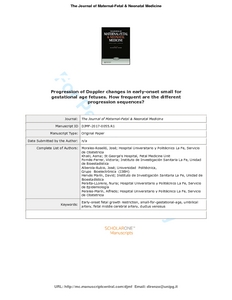Morales-Roselló, J; Khalil, A; Fornés-Ferrer, V; Alberola-Rubio, J; Hervas-Marín, D; Peralta Llorens, N; Perales-Marín, A
(2017)
Progression of Doppler changes in early-onset small for gestational age fetuses. How frequent are the different progression sequences?
J Matern Fetal Neonatal Med, 31 (8).
pp. 1000-1008.
ISSN 1476-4954
https://doi.org/10.1080/14767058.2017.1304910
SGUL Authors: Khalil, Asma
![[img]](http://sgultest.da.ulcc.ac.uk/108882/1.hassmallThumbnailVersion/JMFNM-2017%20Doppler%20progression%20submitted%20version.pdf)  Preview |
|
PDF
Accepted Version
Available under License ["licenses_description_publisher" not defined].
Download (837kB)
| Preview
|
Abstract
OBJECTIVE: To evaluate the progression of Doppler abnormalities in early-onset fetal smallness (SGA). METHODS: A total of 948 Doppler examinations of the umbilical artery (UA), middle cerebral artery (MCA) and ductus venosus (DV), belonging to 405 early-onset SGA fetuses, were studied, evaluating the sequences of Doppler progression, the interval examination-labor at which Doppler became abnormal and the cumulative sum of Doppler anomalies in relation with labor proximity. RESULTS: The most frequent sequences were that in which only the UA pulsatility index (PI) became abnormal (42.1%) and that in which an abnormal UA PI appeared first, followed by an abnormal MCA PI (24.2%). In general, 71.3% of the fetuses followed the classical progression sequence UA→MCA→DV, mostly in the early stages of growth restriction (84.1%). In addition, the UA PI was the first parameter to be affected (9 weeks before delivery), followed by the MCA PI and the DV PIV (1 and 0 weeks). Finally, the UA PI began to sum anomalies 5 weeks before delivery, while the MCA and DV did it at 3 and 1 weeks before the pregnancy ended. CONCLUSIONS: In early-onset SGA fetuses, Doppler progression tends to follow a predictable order, with sequential changes in the umbilical, cerebral and DV impedances.
Statistics
Item downloaded times since 12 Sep 2017.
Actions (login required)
 |
Edit Item |



